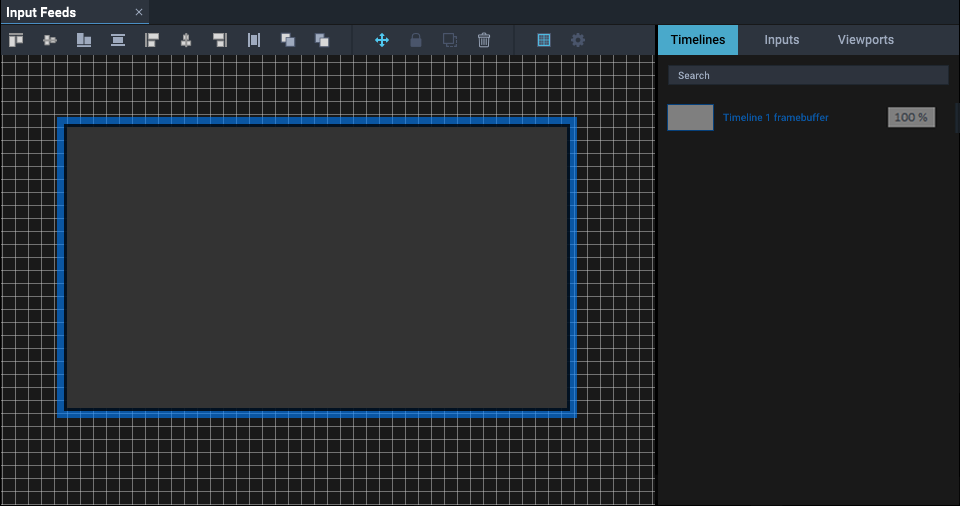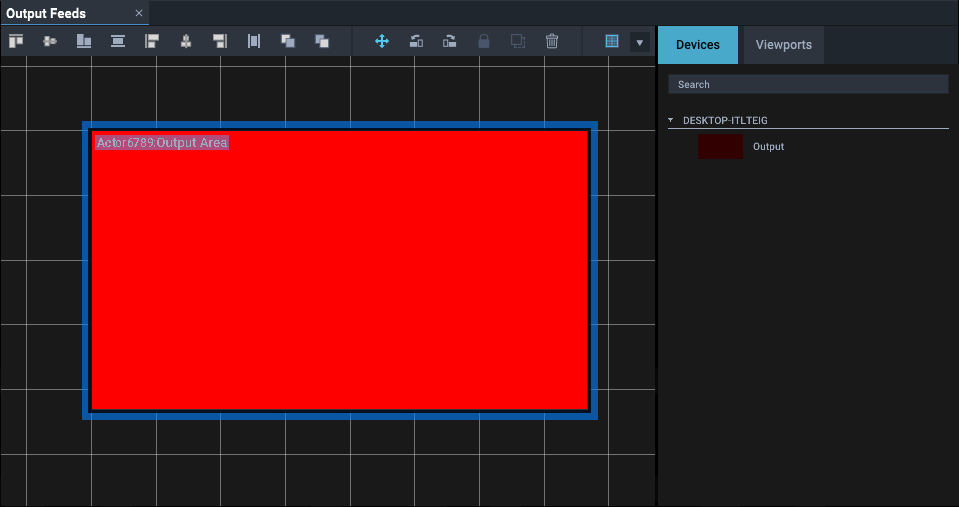Compere allows complete flexibility in directing input stream content onto display surfaces. Requirements are quite diverse, depending on the devices in the project group, what input streams are available, and what display surfaces are being used.
From video input feeds, whether live streaming or from timelines, Compere will paint across any available outputs from Actors in the Project Group. All inputs and outputs for each Actor device in the group will be found in the Project panel.
The resolution of any input is defined by either its native resolution (e.g. an HD camera) or the largest width and height dimensions of any media on a timeline. On a timeline, all media is based on a common origin of 0,0.
Pixels in are conveyed to pixels out via viewports.
A Generalised Workflow
1.Bring the required device video outputs into the Output Feeds panel and arrange them.
2.Bring the required timelines and/or direct inputs into the Input Feeds panel (note the separate listings).
3.Bring viewports onto each input to select the required pixels, bearing in mind the comparative resolutions of source and the outputs where they will be displayed. These viewports will now also be represented in the Output Feeds panel ready for positioning.
4.The viewport output ‘faces’ can be used to scale video pixel selections onto outputs.
5.Make sure that everything is named so that is is clearly identifiable to the users.
•If multiple viewports are assigned to an input, they will be arranged relatively the same, over the outputs. Positional names can be useful (Top Left, Bottom Right, etc.)
•If multiple inputs are assigned to display over a common arrangement of outputs, it is important to be able to identify the viewports by their input names.
If you have multiple timelines captured by a common viewport arrangement in the Input Feeds panel, these can simply be copied for subsequent timelines by right-clicking the new framebuffer in the panel, and clicking ‘Copy viewports from’. Select the required timeline name and click ‘Create’.
How Actor Inputs Relate to Outputs
The required arrangement is set up initially in a pair of panels that work together: the Input Feeds panel and Output Feeds panel. These can be resized and docked, perhaps arranged into a workspace you want to retain for setting up or adjustment.
The Input Feeds panel is where you place inputs and decide the content to take through to device outputs (including only selected areas from timeline framebuffers or streaming sources):

The rectangle here represents the resolution of an input that has been applied. The right-hand panel lists inputs (timelines, cameras, etc.) with their opacity value, and viewports (selections of input resolutions to use, not yet applied here). Multiple inputs can be added here, each with viewports to take to outputs.
•An input will display the source NDI feed.
•A thumbnail for each input added will show under the ‘Inputs’ tab on the right.
The Output Feeds panel is where Actor outputs are assembled into a one or more display areas.
All available outputs (e.g. GPU or ST 2110) from all Actors in a Project Group, are listed in the Devices tab of the Project panel, under each named device. Each output can be dragged into the Output Feeds panel and arranged as in a GPU group or mosaic.

In this illustration, a single output has been added from an Actor and represents initially the native resolution of that output.
Viewports: getting inputs to outputs
Viewports are pixel streams with an input face and an output face. They are created by placing the input face on a single video input, and so can only be added and deleted from the Input (not the output). The output face then appears in the Output Feeds panel. Placed over one or many outputs, they represent the areas on the combined outputs where visual media will be displayed.
A viewport input face selects pixels, a viewport output face scales and displays them. Both faces are represented in NDI in the input and output panels, and available viewports are listed and can be selected to the right of these panels.
Various possibilities of application are shown in I/O Layouts and Layering.
Both of these panels have optional positioning grids, a side panel listing the objects in the main panel, and a toolbar. The toolbars have intuitive alignment layering tools, and a ‘move’ toggle that locks the contents to the grid once everything is positioned. The toolbar is the same for both panels apart from the icons to rotate a viewport on the output side.

When the toolbar is shortened, a drop-down list of the hidden icons is added at the end.
Use the mouse wheel to zoom in and out. The grids can be mouse-dragged (panned) with everything on them, and timelines, outputs and viewports can be dragged over the grids. Toggle the ‘move’ icon to prevent accidental further movement with the mouse. Alternatively, precise positioning of all contents can be given using the properties panel.
Identifying Elements in the Project Panel
The Project panel is divided into two branching lists, Project Tree and Devices.
The Devices tab lists the hardware on the network with in and out connectors, and from this, selected outputs are brought in to create combined output area.
The Project Tree contains branches for the Input Feeds and Output Feeds panels, listing a frame buffer for each input, and its corresponding viewports.
A viewport input has size and position in relation to the input to which it belongs, since it is just a selection area.
An viewport output has its own position and size, so it is scalable, and can be rotated in 90 degree intervals. The output position can be linked to its input position to move together, if required.
Selecting Elements in the I/O Feed Panels
When multiple viewports are placed on inputs or outputs in the feed panels, it can be difficult to grab something that has been overlaid, using a mouse. Anything in either feed panel can be brought forward or sent back to facilitate this, by right-clicking on it in the Project Tree to change its order. Multiple viewports on an input will retain their order relative to the input when its order is changed, for example.
Page edited [d/m/y]: 18/07/2024